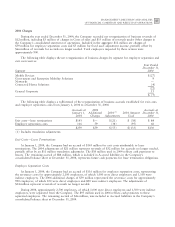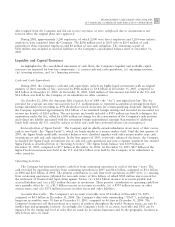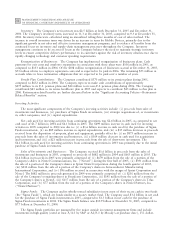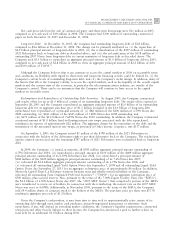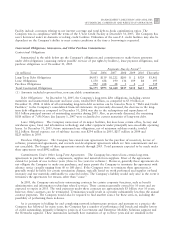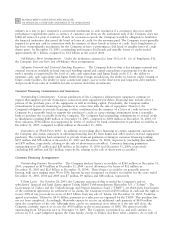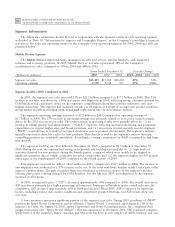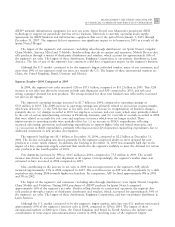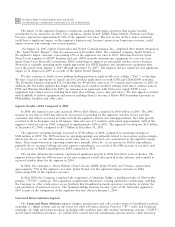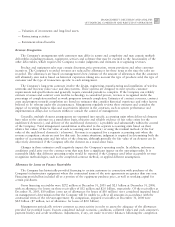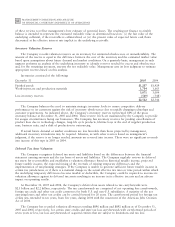Motorola 2005 Annual Report Download - page 66
Download and view the complete annual report
Please find page 66 of the 2005 Motorola annual report below. You can navigate through the pages in the report by either clicking on the pages listed below, or by using the keyword search tool below to find specific information within the annual report.
59
MANAGEMENT'S DISCUSSION AND ANALYSIS
OF FINANCIAL CONDITION AND RESULTS OF OPERATIONS
difficulties in collecting the amounts due from Telsim, the Company had previously recorded charges reducing the
net receivable from Telsim to zero. The net receivable from Telsim has been zero since 2002.
Sales of Receivables and Loans: From time to time, the Company sells short-term receivables, long-term
loans and lease receivables under sales-type leases (collectively, ""finance receivables'') to third parties in
transactions that qualify as ""true-sales.'' Certain of these finance receivables are sold to third parties on a one-time,
non-recourse basis, while others are sold to third parties under committed facilities that involve contractual
commitments from these parties to purchase qualifying receivables up to an outstanding monetary limit. Committed
facilities may be revolving in nature. Certain sales may be made through separate legal entities that are also
consolidated by the Company. The Company may or may not retain the obligation to service the sold finance
receivables.
In the aggregate, at December 31, 2005, these committed facilities provided for up to $1.1 billion to be
outstanding with the third parties at any time, as compared to up to $724 million provided at December 31, 2004
and up to $598 million provided at December 31, 2003. As of December 31, 2005, $585 million of these
committed facilities were utilized, compared to $305 million utilized at December 31, 2004 and $295 million
utilized at December 31, 2003. Certain events could cause one of these facilities to terminate. In addition, before
receivables can be sold under certain of the committed facilities they may need to meet contractual requirements,
such as credit quality or insurability.
Total finance receivables sold by the Company were $4.5 billion in 2005 (including $4.2 billion of short-term
receivables), compared to $3.8 billion sold in 2004 (including $3.8 billion of short-term receivables) and
$2.8 billion sold in 2003 (including $2.7 billion of short-term receivables). As of December 31, 2005, there were
$1.0 billion of receivables outstanding under these programs for which the Company retained servicing obligations
(including $838 million of short-term receivables), compared to $720 million outstanding at December 31, 2004
(including $589 of short-term receivables) and $557 million outstanding at December 31, 2003 (including $378 of
short-term receivables).
Under certain of the receivables programs, the value of the receivables sold is covered by credit insurance
obtained from independent insurance companies, less deductibles or self-insurance requirements under the policies
(with the Company retaining credit exposure for the remaining portion). The Company's total credit exposure to
outstanding short-term receivables that have been sold was $66 million at December 31, 2005 as compared to
$25 million at December 31, 2004. Reserves of $4 million were recorded for potential losses on sold receivables at
both December 31, 2005 and December 31, 2004.
Other Contingencies
Potential Contractual Damage Claims in Excess of Underlying Contract Value: In certain circumstances, our
businesses may enter into contracts with customers pursuant to which the damages that could be claimed by the
other party for failed performance might exceed the revenue the Company receives from the contract. Contracts
with these sorts of uncapped damage provisions are fairly rare, but individual contracts could still represent
meaningful risk. Although it has not previously happened to the Company, there is a possibility that a damage claim
by a counterparty to one of these contracts could result in expenses to the Company that are far in excess of the
revenue received from the counterparty in connection with the contract.
Legal Matters: The Company has several lawsuits filed against it relating to the Iridium program, as further
described under ""Item 3: Legal Proceedings'' of this document. The Company has not reserved for any potential
liability that may arise as a result of litigation related to the Iridium program. While the still pending cases are in
preliminary stages and the outcomes are not predictable, an unfavorable outcome of one or more of these cases
could have a material adverse effect on the Company's consolidated financial position, liquidity or results of
operations.
The Company is a defendant in various other lawsuits, including product-related suits, and is subject to various
claims which arise in the normal course of business. In the opinion of management, and other than discussed above
with respect to the still pending Iridium cases, the ultimate disposition of these matters will not have a material
adverse effect on the Company's consolidated financial position, liquidity or results of operations.


